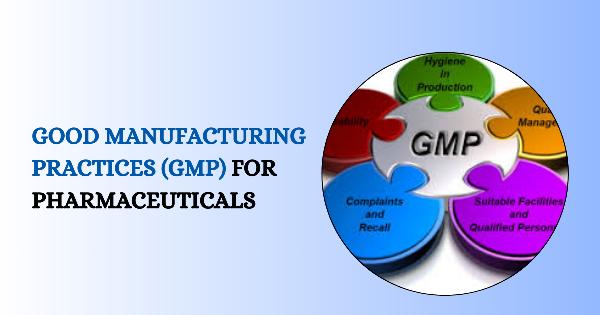Good Manufacturing Practices (GMP) for Pharmaceuticals

Strong 8k brings an ultra-HD IPTV experience to your living room and your pocket.
Good Manufacturing Practices Introduction
Good Manufacturing Practices (GMP) are a set of guidelines and regulations that pharmaceutical manufacturers must follow to ensure the safety, quality, and efficacy of their products. GMPs cover all aspects of pharmaceutical manufacturing, from the sourcing of raw materials to the distribution of finished products.
Essential GMP requirements for pharmaceuticals:
Quality control: To make sure that their products fulfil all quality requirements, pharmaceutical manufacturers need to have a robust quality control system in place. Testing of raw materials, intermediate products, and final products is included in this.
Documentation: All manufacturing processes, including batch records, quality control data, and complaint investigations, must be meticulously documented by manufacturers.
Validation: All manufacturing processes must be validated to ensure that they are capable of producing products of consistent quality.
Hygiene and sanitation: In order to prevent product contamination, the manufacturing environment needs to be hygienic and spotless.
Personnel training: All employees who work in the pharmaceutical manufacturing industry need to be suitably qualified and trained.
Complaint handling: Producers need to have a procedure in place for managing and looking into product complaints.
The Fundamentals of Good Manufacturing Practices (GMP)
Good Manufacturing Practices (GMP) are a set of guidelines and regulations that pharmaceutical manufacturers must follow to ensure the safety, quality, and efficacy of their products. These principles are essential for protecting public health and maintaining consumer confidence in the pharmaceutical industry.
Critical Components of GMP:
Quality Control:
Testing and inspection: Implementing rigorous testing and inspection procedures to verify the quality of raw materials, intermediate products, and finished goods.
Documentation: Maintaining accurate and complete records of all quality control activities.
Personnel:
Training and qualification: Ensuring that all personnel involved in pharmaceutical manufacturing are adequately trained and qualified for their roles.
Hygiene and sanitation: Promoting good hygiene practices among all personnel to prevent contamination.
Facilities and Equipment:
Design and maintenance: Maintaining clean, well-maintained facilities and equipment that are suitable for pharmaceutical manufacturing.
Validation: Validating manufacturing processes and equipment to ensure they are capable of producing products of consistent quality.
Production and Process Control:
Standard Operating Procedures (SOPs): Developing and following clear SOPs for all manufacturing processes.
Deviation investigation: Investigating and documenting any deviations from SOPs to identify and address root causes.
Documentation:
Recordkeeping: Maintaining accurate and complete records of all manufacturing activities, including batch records, quality control data, and complaint investigations.
Retention: Retaining records for a specified period to comply with regulatory requirements.
Complaint Handling:
Investigation: Promptly investigate and document all complaints received regarding product quality.
Corrective actions: Implementing corrective actions to address the root causes of complaints and prevent recurrence.
How to obtain a GMP certificate:
Pharmaceutical manufacturers need to pass a stringent audit conducted by a third-party certification body or regulatory body in order to receive a GMP certificate. The manufacturer's compliance with GMP regulations will be evaluated by the audit. The manufacturer will receive a GMP certificate if it is determined that they are in compliance.
What does the FDA define as good manufacturing practices (GMP)?
The FDA defines Current Good Manufacturing Practices (CGMPs) as a set of regulations that ensure the quality, safety, and efficacy of drugs.
These regulations cover various aspects of the manufacturing process, including:
- Facilities and equipment
- Personnel
- Quality control
- Documentation
- Complaint handling
What are 21 CFR parts 210 and 211
21 CFR parts 210 and 211 are two critical regulations under the Food and Drug Administration's (FDA) Current Good Manufacturing Practices (CGMP) regulations for pharmaceuticals. They provide specific guidelines and requirements for pharmaceutical manufacturers to ensure the quality, safety, and efficacy of their products.
21 CFR Part 210 is a general regulation that outlines the basic requirements for all pharmaceutical manufacturers
Equipment plays a crucial role in pharmaceutical manufacturing, ensuring the quality, safety, and consistency of products. Adherence to Good Manufacturing Practices (GMP) is essential for the design, manufacture, and maintenance of equipment used in pharmaceutical production.
GMP Considerations for Equipment Design and Manufacture:
Compatibility: Equipment must be compatible with the specific products and processes involved. This includes factors such as materials of construction, cleaning procedures, and sterilization methods.
Cleanability: Equipment should be designed for easy cleaning and sanitization to prevent contamination. This may involve the use of smooth surfaces, rounded corners, and removable parts.
Sterility: Equipment used for aseptic processing should be designed to maintain sterility. This may include features such as steam-in-place (SIP) or hot water circulation (HWC) systems.
Validation: Equipment should be validated to ensure that it is capable of performing its intended function. This involves testing and documentation of the equipment's performance.
Documentation: Detailed documentation is required for equipment design, manufacture, installation, and maintenance. This includes specifications, drawings, and validation records.
Bottom line:
Pharmaceutical safety, efficacy, and quality can only be guaranteed by GMPs. By following GMP guidelines, pharmaceutical manufacturers can protect the health of consumers and maintain their reputations.
Read the related blog:
World Manufacturer Identifier
Note: IndiBlogHub features both user-submitted and editorial content. We do not verify third-party contributions. Read our Disclaimer and Privacy Policyfor details.







